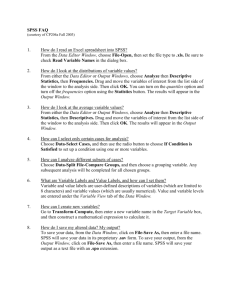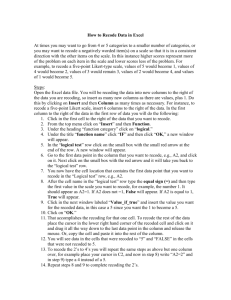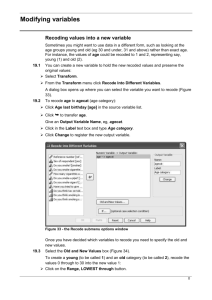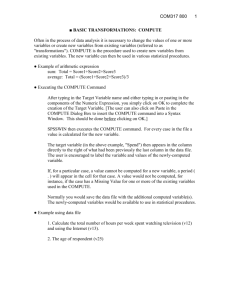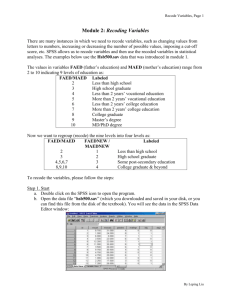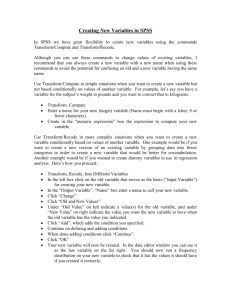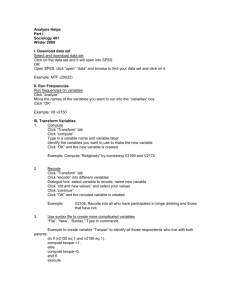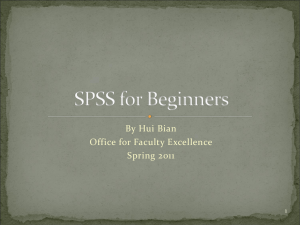Title Syntax
advertisement
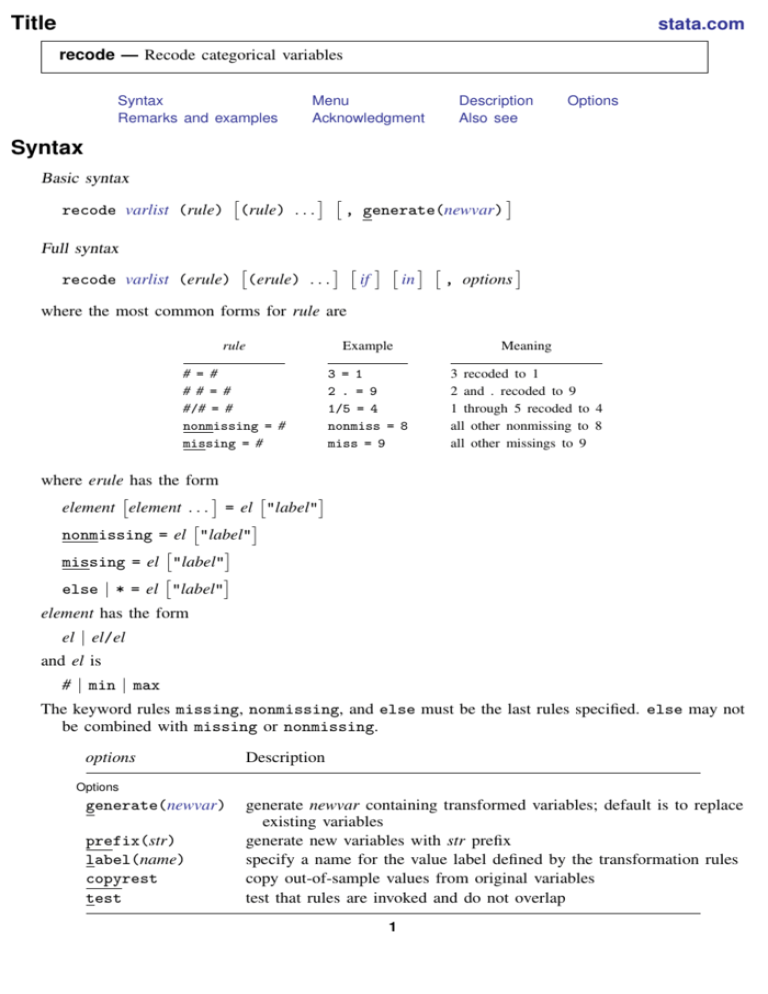
Title
stata.com
recode — Recode categorical variables
Syntax
Remarks and examples
Menu
Acknowledgment
Description
Also see
Options
Syntax
Basic syntax
recode varlist (rule) (rule) . . .
, generate(newvar)
Full syntax
recode varlist (erule) (erule) . . .
if
in
, options
where the most common forms for rule are
rule
Example
Meaning
# = #
# # = #
#/# = #
nonmissing = #
missing = #
3 = 1
2 . = 9
1/5 = 4
nonmiss = 8
miss = 9
3 recoded to 1
2 and . recoded to 9
1 through 5 recoded to 4
all other nonmissing to 8
all other missings to 9
where erule has the form
element element . . . = el "label"
nonmissing = el "label"
missing = el "label"
else | * = el "label"
element has the form
el | el/el
and el is
# | min | max
The keyword rules missing, nonmissing, and else must be the last rules specified. else may not
be combined with missing or nonmissing.
options
Description
Options
generate(newvar)
prefix(str)
label(name)
copyrest
test
generate newvar containing transformed variables; default is to replace
existing variables
generate new variables with str prefix
specify a name for the value label defined by the transformation rules
copy out-of-sample values from original variables
test that rules are invoked and do not overlap
1
2
recode — Recode categorical variables
Menu
Data
>
Create or change data
>
Other variable-transformation commands
>
Recode categorical variable
Description
recode changes the values of numeric variables according to the rules specified. Values that do
not meet any of the conditions of the rules are left unchanged, unless an otherwise rule is specified.
A range #1/#2 refers to all (real and integer) values between #1 and #2, including the boundaries
#1 and #2. This interpretation of #1/#2 differs from that in numlists.
min and max provide a convenient way to refer to the minimum and maximum for each variable in
varlist and may be used in both the from-value and the to-value parts of the specification. Combined
with if and in, the minimum and maximum are determined over the restricted dataset.
The keyword rules specify transformations for values not changed by the previous rules:
nonmissing
missing
else
*
all nonmissing values not changed by the rules
all missing values (., .a, .b, . . . , .z) not changed by the rules
all nonmissing and missing values not changed by the rules
synonym for else
recode provides a convenient way to define value labels for the generated variables during the
definition of the transformation, reducing the risk of inconsistencies between the definition and value
labeling of variables. Value labels may be defined for integer values and for the extended missing
values (.a, .b, . . . , .z), but not for noninteger values or for sysmiss (.).
Although this is not shown in the syntax diagram, the parentheses around the rules and keyword
clauses are optional if you transform only one variable and if you do not define value labels.
Options
Options
generate(newvar) specifies the names of the variables that will contain the transformed variables.
into() is a synonym for generate(). Values outside the range implied by if or in are set to
missing (.), unless the copyrest option is specified.
If generate() is not specified, the input variables are overwritten; values outside the if or in
range are not modified. Overwriting variables is dangerous (you cannot undo changes, value labels
may be wrong, etc.), so we strongly recommend specifying generate().
prefix(str) specifies that the recoded variables be returned in new variables formed by prefixing
the names of the original variables with str.
label(name) specifies a name for the value label defined from the transformation rules. label()
may be defined only with generate() (or its synonym, into()) and prefix(). If a variable is
recoded, the label name defaults to newvar unless a label with that name already exists.
copyrest specifies that out-of-sample values be copied from the original variables. In line with
other data management commands, recode defaults to setting newvar to missing (.) outside the
observations selected by if exp and in range.
test specifies that Stata test whether rules are ever invoked or that rules overlap; for example,
(1/5=1) (3=2).
recode — Recode categorical variables
Remarks and examples
3
stata.com
Remarks are presented under the following headings:
Simple examples
Setting up value labels with recode
Referring to the minimum and maximum in rules
Recoding missing values
Recoding subsets of the data
Otherwise rules
Test for overlapping rules
Simple examples
Many users experienced with other statistical software use the recode command often, but easier
and faster solutions in Stata are available. On the other hand, recode often provides simple ways to
manipulate variables that are not easily accomplished otherwise. Therefore, we show other ways to
perform a series of tasks with and without recode.
We want to change 1 to 2, leave all other values unchanged, and store the results in the new variable
nx.
. recode x (1 = 2), gen(nx)
or
. gen nx = x
. replace nx = 2 if nx==1
or
. gen nx = cond(x==1,2,x)
We want to swap 1 and 2, saving them in nx.
. recode x (1 = 2) (2 = 1), gen(nx)
or
. gen nx = cond(x==1,2,cond(x==2,1,x))
We want to recode item by collapsing 1 and 2 into 1, 3 into 2, and 4 to 7 (boundaries included)
into 3.
. recode item (1 2 = 1) (3 = 2) (4/7 = 3), gen(Ritem)
or
.
.
.
.
gen Ritem = item
replace Ritem = 1 if inlist(item,1,2)
replace Ritem = 2 if item==3
replace Ritem = 3 if inrange(item,4,7)
We want to change the “direction” of the 1, . . . , 5 valued variables x1, x2, x3, storing the transformed
variables in nx1, nx2, and nx3 (that is, we form new variable names by prefixing old variable
names with an “n”).
. recode x1 x2 x3 (1=5) (2=4) (3=3) (4=2) (5=1), pre(n) test
or
. gen nx1 = 6-x1
. gen nx2 = 6-x2
4
recode — Recode categorical variables
. gen nx3 = 6-x3
. forvalues i = 1/3 {
generate nx‘i’ = 6-x‘i’
}
In the categorical variable religion, we want to change 1, 3, and the real and integer numbers 3
through 5 into 6; we want to set 2, 8, and 10 to 3 and leave all other values unchanged.
. recode religion 1 3/5 = 6 2 8 10 = 3
or
. replace religion = 6 if religion==1 | inrange(religion,3,5)
. replace religion = 3 if inlist(religion,2,8,10)
This example illustrates two features of recode that were included for backward compatibility
with previous versions of recode but that we do not recommend. First, we omitted the parentheses
around the rules. This is allowed if you recode one variable and you do not plan to define value labels
with recode (see below for an explanation of this feature). Personally, we find the syntax without
parentheses hard to read, although we admit that we could have used blanks more sensibly. Because
difficulties in reading may cause us to overlook errors, we recommend always including parentheses.
Second, because we did not specify a generate() option, we overwrite the religion variable. This
is often dangerous, especially for “original” variables in a dataset. We recommend that you always
specify generate() unless you want to overwrite your data.
Setting up value labels with recode
The recode command is most often used to transform categorical variables, which are many times
value labeled. When a value-labeled variable is overwritten by recode, it may well be that the value
label is no longer appropriate. Consequently, output that is labeled using these value labels may be
misleading or wrong.
When recode creates one or more new variables with a new classification, you may want to put
value labels on these new variables. It is possible to do this in three steps:
1. Create the new variables (recode . . . , gen()).
2. Define the value label (label define . . . ).
3. Link the value label to the variables (label value . . . ).
Inconsistencies may emerge from mistakes between steps 1 and 2. Especially when you make
a change to the recode 1, it is easy to forget to make a similar adjustment to the value label 2.
Therefore, recode can perform steps 2 and 3 itself.
Consider recoding a series of items with values
1
2
3
4
5
=
=
=
=
=
strongly agree
agree
neutral
disagree
strongly disagree
into three items:
1 = positive (= “strongly agree” or “agree”)
2 = neutral
3 = negative (= “strongly disagree” or “disagree”)
recode — Recode categorical variables
5
This is accomplished by typing
. recode item* (1 2 = 1 positive) (3 = 2 neutral) (4 5 = 3 negative), pre(R)
> label(Item3)
which is much simpler and safer than
. recode item1-item7 (1 2 = 1) (3 = 2) (4 5 = 3), pre(R)
. label define Item3 1 positive 2 neutral 3 negative
. forvalues i = 1/7 {
label value Ritem‘i’ Item3
}
Example 1
As another example, let’s recode vote (voting intentions) for 12 political parties in the Dutch
parliament into left, center, and right parties. We then tabulate the original and new variables so that
we can check that everything came out correctly.
. use http://www.stata-press.com/data/r13/recodexmpl
. label list pparty
pparty:
1 pvda
2 cda
3 d66
4 vvd
5 groenlinks
6 sgp
7 rpf
8 gpv
9 aov
10 unie55
11 sp
12 cd
. recode polpref (1 5 11 = 1 left) (2 3 = 2 center) (4 6/10 12 = 3 right),
> gen(polpref3)
(2020 differences between polpref and polpref3)
. tabulate polpref polpref3
RECODE of polpref (pol party
pol party
choice if
choice if elections)
left
center
right
Total
elections
pvda
cda
d66
vvd
groenlinks
sgp
rpf
gpv
aov
unie55
sp
cd
622
0
0
0
199
0
0
0
0
0
45
0
0
525
634
0
0
0
0
0
0
0
0
0
0
0
0
930
0
54
63
30
17
23
0
25
622
525
634
930
199
54
63
30
17
23
45
25
Total
866
1,159
1,142
3,167
6
recode — Recode categorical variables
Referring to the minimum and maximum in rules
recode allows you to refer to the minimum and maximum of a variable in the transformation
rules. The keywords min and max may be included as a from-value, as well as a to-value.
For example, we might divide age into age categories, storing in iage.
. recode age (0/9=1) (10/19=2) (20/29=3) (30/39=4) (40/49=5) (50/max=6),
> gen(iage)
or
. gen iage = 1 + irecode(age,9,19,29,39,49)
or
. gen iage = min(6, 1+int(age/10))
As another example, we could set all incomes less than 10,000 to 10,000 and those more than
200,000 to 200,000, storing the data in ninc.
. recode inc (min/10000 = 10000) (200000/max = 200000), gen(ninc)
or
. gen ninc = inc
. replace ninc = 10000 if ninc<10000
. replace ninc = 200000 if ninc>200000 & !missing(ninc)
or
. gen ninc = max(min(inc,200000),10000)
or
. gen ninc = clip(inc,10000,200000)
Recoding missing values
You can also set up rules in terms of missing values, either as from-values or as to-values. Here
recode mimics the functionality of mvdecode and mvencode (see [D] mvencode), although these
specialized commands execute much faster.
Say that we want to change missing (.) to 9, storing the data in X:
. recode x (.=9), gen(X)
or
. gen X = cond(x==., 9, x)
or
. mvencode x, mv(.=9) gen(X)
We want to change 9 to .a and 8 to ., storing the data in z.
. recode x (9=.a) (8=.), gen(z)
or
. gen z = cond(x==9, .a, cond(x==8, ., x))
or
. mvdecode x, mv(9=.a, 8=.) gen(z)
recode — Recode categorical variables
7
Recoding subsets of the data
We want to swap in x the values 1 and 2 only for those observations for which age>40, leaving
all other values unchanged. We issue the command
. recode x (1=2) (2=1) if age>40, gen(y)
or
. gen y = cond(x==1,2,cond(x==2,1,x)) if age>40
We are in for a surprise. y is missing for observations that do not satisfy the if condition. This
outcome is in accordance with how Stata’s data manipulation commands usually work. However, it
may not be what you intend. The copyrest option specifies that x be copied into y for all nonselected
observations:
. recode x (1=2) (2=1) if age>40, gen(y) copy
or
. gen y = x
. recode y (1=2) (2=1) if age>40
or
. gen y = cond(age>40,cond(x==1,2,cond(x==2,1,x),x))
Otherwise rules
In all our examples so far, recode had an implicit rule that specified that values that did not
meet the conditions of any of the rules were to be left unchanged. recode also allows you to use an
“otherwise rule” to specify how untransformed values are to be transformed. recode supports three
kinds of otherwise conditions:
nonmissing
missing
else
all nonmissing not yet transformed
all missing values not yet transformed
all values, missing or nonmissing, not yet transformed
The otherwise rules are to be specified after the standard transformation rules. nonmissing and
missing may be combined with each other, but not with else.
Consider a recode that swaps the values 1 and 2, transforms all other nonmissing values to 3, and
transforms all missing values (that is, sysmiss and the extended missing values) to . (sysmiss). We
could type
. recode x (1=2) (2=1) (nonmissing=3) (missing=.), gen(z)
or
. gen z = cond(x==1,2,cond(x==2,1,cond(!missing(x),3),.))
As a variation, if we had decided to recode all extended missing values to .a but to keep sysmiss
. distinct at ., we could have typed
. recode x (1=2) (2=1) (.=.) (nonmissing=3) (missing=.a), gen(z)
8
recode — Recode categorical variables
Test for overlapping rules
recode evaluates the rules from left to right. Once a value has been transformed, it will not be
transformed again. Thus if rules “overlap”, the first matching rule is applied, and further matches are
ignored. A common form of overlapping is illustrated in the following example:
... (1/5 = 1) (5/10 = 2)
Here 5 occurs in the condition parts of both rules. Because rules are matched left to right, 5 matches
the first rule, and the second rule will not be tested for 5, unless recode is instructed to test for rule
overlap with the test option.
Other instances of overlapping rules usually arise because you mistyped the rules. For instance,
you are recoding voting intentions for parties in elections into three groups of parties (left, center,
right), and you type
... (1/5 = 1) ... (3 = 2)
Party 3 matches the conditions 1/5 and 3. Because recode applies the first matching rule, party 3
will be mapped into party category 1. The second matching rule is ignored. It is not clear what was
wrong in this example. You may have included party 3 in the range 1/5 or mistyped 3 in the second
rule. Either way, recode did not notice the problem and your data analysis is in jeopardy. The test
option specifies that recode display a warning message if values are matched by more than one
rule. With the test option specified, recode also tests whether all rules were applied at least once
and displays a warning message otherwise. Rules that never matched any data may indicate that you
mistyped a rule, although some conditions may not have applied to (a selection of) your data.
Acknowledgment
This version of recode was written by Jeroen Weesie of the Department of Sociology at Utrecht
University, The Netherlands.
Also see
[D] generate — Create or change contents of variable
[D] mvencode — Change missing values to numeric values and vice versa
